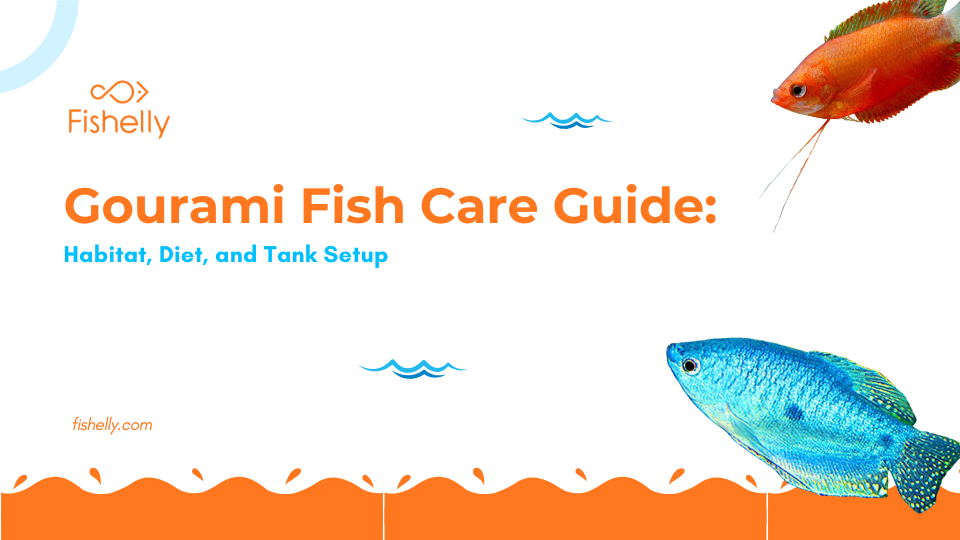Gourami Fish Care Guide: Habitat, Diet, and Tank Setup
Learn everything about Gourami fish, including habitat, species, diet, tank setup, and breeding habits. Discover the best care tips to keep your Gouramis healthy and thriving.
Table of Contents
- Native Habitat
- Species Diversity
- Lifespan and Longevity
- Breeding Habits
- Survival Mechanisms
- Group Behavior
- Geographical Distribution
- Maximum Size
- Maintenance of Gouramis in an Aquarium
- Food and Diet Plan
- Male and Female Differences Between of Gourami Fish
- Dos and Don'ts with Gourami Fish
- Fun Facts About Gouramis Fish
- Faq
- Conclusion
Gourami fish are a colorful and fascinating family of freshwater fish indigenous to Southeast Asia. Due to their brilliant colors, interesting behavior, and tolerance, they are among the most sought-after fish in aquarium hobbyists. Being capable of breathing air with a special labyrinth organ, Gouramis thrive under a range of water conditions, from slow streams to rice paddy fields. Their calm temperament, striking designs, and interesting breeding behaviors make them a great choice for beginner and advanced aquarists' tanks alike.

Native Habitat
Gouramis are native to Southeast Asia, with most of them being found in India, Thailand, Malaysia, and Indonesia. They live in slow-moving or stagnant water like swamps, marshes, and rice fields. Their labyrinth organ enables them to breathe air from the atmosphere, making them thrive in waters with low oxygen levels.
Species Diversity
There are more than 90 known species of Gourami that vary in size, color, and personality. Some of the most common species used in aquarium trade are:• Dwarf Gourami (Trichogaster lalius): Peaceful, small, and colorful.

• Pearl Gourami (Trichopodus leerii): Unique in appearance due to its pearlescent scales and dainty fins.

• Kissing Gourami (Helostoma temminckii): Renowned for its "kissing" act.

• Three-Spot Gourami (Trichopodus trichopterus): Robust and versatile.

• Giant Gourami (Osphronemus goramy): The biggest of the lot, reaching a length of 28 inches (70 cm).

Lifespan and Longevity
Gouramis live 4 to 8 years if well taken care of, whereas bigger species such as the Giant Gourami can live for 15 years. A clean tank, a balanced diet, and an absence of stress contribute to their long lifespan.Breeding Habits
The majority of Gouramis are bubble nest builders, i.e., the males construct a floating nest of bubbles and plant material. The male then guards the eggs aggressively after spawning until they hatch. There are some species, such as the Kissing Gourami, which have other breeding habits.
Survival Mechanisms
Gouramis have a labyrinth organ that allows them to breathe oxygen from the air, thereby making them comfortable in oxygen-depleted environments. Their resilience in different water conditions has aided in their survival in both the wild and aquarium setups.
Group Behavior
While some species, such as Dwarf and Pearl Gouramis, prefer living in small groups, others can be territorial and do better alone or in carefully selected tankmate settings. Males tend to be more aggressive, especially during breeding season.

Geographical Distribution
Gouramis are widely distributed across Southeast Asia, extending from India to Indonesia. Some species have been introduced to other tropical regions, including parts of Africa and South America.
Maximum Size
Gourami species come in a wide range of sizes. The Dwarf Gourami measures around 3 inches (7.5 cm), while the Giant Gourami measures an impressive 28 inches (70 cm).
Maintenance of Gouramis in an Aquarium
Optimal Water Conditions
• Temperature: 72-82°F (22-28°C)
• pH Level: 6.0-7.5
• Water Hardness: Soft to moderately hard
• Tank Size: Minimum 10 gallons for small species, 50+ gallons for larger species
• Filtration: Moderate with gentle water flow
Tank Setup
• Offer plants and hiding places for a natural setting.
• Maintain low to moderate lighting to simulate their natural environment.
• Hold floating plants in place to stimulate bubble-nest construction.
• Do not use strong currents, as they like peaceful waters.
Food and Diet Plan
Gouramis are omnivores, so they consume plant and animal foods. A well-balanced diet consists of:
• High-quality flakes or pellets as a mainstay.

• Live or frozen foods such as bloodworms, brine shrimp, and daphnia.

• Vegetables such as blanched spinach or peas.

Feeding 2-3 times a day in small quantities avoids overfeeding and tank pollution.
Male and Female Differences Between of Gourami Fish
Male Gourami Fish
• Males tend to be more colored and have longer, pointed dorsal fins.
• Males are more aggressive, particularly during breeding.

Female Gourami Fish
• Females are more rounded in the body and less colored.

Dos and Don'ts with Gourami Fish
Dos:
• Maintain them in well-maintained, stable water conditions.
• Offer plenty of plants and hiding places.
• Regularly check tankmate compatibility to prevent aggression.
• Feed a varied and balanced diet.
• Perform routine water changes (20-30% weekly).
Don'ts:
• Avoid keeping two male Gouramis in small tanks because of aggression.
• Don't overcrowd the tank, as they require space to flourish.
• Avoid strong currents of water, which stress them out.
• Don't feed them with low-quality food, as it impacts their health.
• Avoid sudden changes of water, which stress them out.
Fun Facts About Gouramis Fish
• Gouramis breathe air because they have a labyrinth organ.
• Kissing Gouramis don't really "kiss" but exhibit dominance.
• Some of the species are able to produce grunting or croaking noises.
• Dwarf Gouramis are among the most colorful of freshwater fish.
• They are regarded as being clever and interactive fish.
Faq
1. What makes Gouramis unique?
They have a labyrinth organ that lets them breathe air.
2. How big do they get?
Dwarf Gouramis: 3 inches, Giant Gouramis: 28 inches.
3. Are they beginner-friendly?
Yes, they are hardy and easy to care for.
4. What tank size do they need?
Small species: 10 gallons, large species: 50+ gallons.
5. Are they aggressive?
Males can be territorial, especially during breeding.
6. What do they eat?
Flakes, pellets, live/frozen food, and veggies.
7. How often should I feed them?
2-3 times daily in small amounts.
8. Can I keep two males together?
No, they may fight.
9. Do they need a filter?
Yes, with a gentle water flow.
10. How to tell male from female?
Males are more colorful with pointed fins.
11. Do they need plants?
Yes, they like live plants and hiding spots.
12. Ideal water temperature?
72-82°F (22-28°C).
13. How do they breed?
Males build bubble nests and guard eggs.
14. Lifespan?
4-8 years, up to 15 for larger species.
15. Can they make sounds?
Yes, some grunt or croak.
16. Are they good with other fish?
Yes, but avoid aggressive tankmates.
17. Why do Kissing Gouramis "kiss"?
It’s a display of dominance.
18. Do they need an air pump?
No, they breathe air but need clean water.
19. How often to change water?
Weekly, 20-30%.
20. Common mistakes?
Overcrowding, strong currents, bad tankmates, poor diet.
Conclusion
Gourami fish are a perfect option for beginner and advanced aquarists alike. Their stunning looks, fascinating behavior, and robust health ensure that they are a pleasure to keep. As long as they receive proper care, a comfortable environment, and a nutritious diet, these fish will flourish and add life to your aquarium. Whether you seek a calm community fish or a colorful showpiece, there is a Gourami species for your tank!
Have questions? Drop a comment below! #fishelly_official Fish Community















